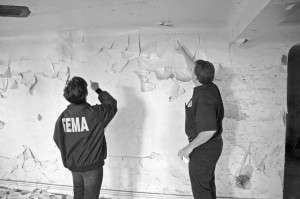New Orleans enforces lead paint laws
2nd January 2013 · 0 Comments
By Susan Buchanan
Contributing Writer
With homes being redone on nearly every block in town, you occasionally spot a cloud of dust and worry if it might contain lead and other contaminants. For its part, the city is strengthening enforcement of lead-paint removal rules, and the City Council is trying to keep tabs on the issue. According to federal researchers, a speck of lead dust is enough to poison a child and can cause irreparable brain damage to kids under seven years old. Pregnant women are also at risk.
At a City Council Housing and Human Needs Committee meeting, chaired by Stacy Head on Dec. 17, newly-appointed Dept. of Safety & Permits director Jared Munster displayed his agency’s revised Lead-Based Paint Removal Form. The latest form, enforcing a city ordinance adopted in 2001, includes more resources and guidelines on safe practices than the last one, and was posted on the agency’s website in mid-December. Contractors and others removing lead paint are required to file it, with the location, scope and dates of their projects. On the form, the city says that occupants of a building that’s being lead-remediated must be notified three days before work starts.

FEMA inspectors examine peeling, lead paint in a New Orleans house after Katrina. Photo courtesy of FEMA
Under state law, “full lead abatement” or an all-encompassing job has to be done by a licensed, lead-paint removal contractor. Meanwhile, the city is concerned about unlicensed firms and also by do-it-yourselfers—who start chipping away at old paint without necessarily knowing hazards and related rules.
At the December 17 meeting, Council members said they’re aware of at least some contractors who remove lead paint on weekends when inspectors aren’t around. The public doesn’t have phone access to the city’s single, lead-paint inspector assigned to weekend duty, they noted.
Nonetheless, the city has made progress in its battle against lead, which was banned from U.S. gasoline in 1986. Lead-based, household paint was outlawed in 1978. And in recent years, lead-contaminated soil in many of the city’s playgrounds and schools was replaced.
Hazards remain, particularly as houses built before 1978 are renovated, Andrew Rodgers, owner of Rodgers and Associates in Kenner, said last week. He’s a certified industrial hygienist, who does child blood-lead-level investigations. When lead levels in soil or elsewhere are elevated, “a child gets dust on his hands, swallows it, and the lead slows his development,” he said. “Young children are absorbing calcium for their bones. However, some of them are also sucking up lead.”
Rodgers said the U.S. Dept of Housing and Urban Development, Louisiana’s Dept of Health and Hospitals and Dept. of Environmental Quality, and the city are all vigilant in their fight against lead poisoning.
Federal guidelines require blood-lead testing at specified periods for all young children. Lead risk assessments are given at well-baby visits for kids up to six years of age. Results of blood lead tests for children under age six have to be reported to the state’s Lead Prevention Program. And the New Orleans Childhood Lead Poisoning Prevention Program must be notified immediately of any serious lead cases in the parish.
Rodgers tests children at sites where renovation work has been done, and he said if their blood lead level is high, they’re taken to a hospital for chelation therapy. “That’s when parents get really worried,” he said. “I write a report stating what might have poisoned the child. A child in that situation will be sent to live with their granny or to a safe house until lead removal has been properly done at home.” A third of his work is in Orleans Parish, with the rest in other parts of the state.
“Under U.S. Environmental Protection Agency rules from a year or so ago, work sites are to be tested for lead first,” Rodgers said. “But I don’t see many EPA certificates at sites.”
A study released by Tulane’s School of Public Health and Tropical Medicine in Nov. 2011 found that over 60 percent of homes sampled across the city had lead levels exceeding federal standards. Soil contamination was prevalent. Researchers said the city’s children were at substantial risk for exposure in and around their homes. Other studies, based on soil samples taken soon after Katrina, showed a decline in the city’s lead levels in 2006 because flood waters distributed fresh sediment. But after that, Tulane researchers speculated that demolition and rebuilding kicked up dust from lead-based paint.
The 2011 Tulane study tested indoor dust and yard soil at homes occupied in 2007 and 2008. The median, soil-lead level at sampled homes was 37 percent higher than in a local, lead survey done in 1998 to 2000. In the research published in 2011, lead contamination affected the city’s lower- and high-income neighborhoods alike. Tulane researchers said that while city ordinances required renovators to mitigate lead in paint removal, enforcement was lax. Improper paint sanding was widespread during renovations, they noted.
Some local contractors have cheated on the rules, cutting corners because compliance is expensive. Rodgers pointed to a recent $16,000, lead-paint removal project at a house in St. Charles Parish as an example, and said the cost included insurance polices, contractors’ license fees and equipment.
Under New Orleans city ordinances, ground must be covered under all paint-removal work areas. Containment barriers have to be erected when sanding, grinding, sandblasting, hydro-blasting or high-pressure wash work is under way. If an approved HEPA or High-Efficiency Particulate Air vacuum system is used, containment barriers may not be necessary, however. Under the rules, manual scraping with tools that create paint chips is permitted but the surface should be kept wet. In another rule, exterior paint may be removed chemically with an approved stripper if federal and state guidelines are followed. Removal of exterior paint using propane or acetylene burning is prohibited.
Locally-high lead levels have worrisome consequences. A 2009 study by Colorado State’s Sammy Zahran, Tulane University’s Howard Mielke and their colleagues linked elevated blood lead in children in New Orleans to lower, standardized tests scores. Elevated lead levels in teenagers were associated with reading disabilities, absenteeism, weaker vocabularies, altered reaction times, a greater risk of dropping out of school and an increase in juvenile delinquency.
As for play spots, the city remediated 11 playgrounds for lead in 2011, and in late 2012 worked on Desmare Playground on Esplanade Ave. in Faubourg St. John after finding elevated soil lead levels there.
For questions about lead paint removal, contact the city’s Dept. of Safety & Permits during the week at (504) 658-7100. For information about lead poisoning, phone the city’s Health Department at (504) 658-2565. And for anyone raising vegetables or chickens in their backyard, you may want to ask the city about soil conditions in your neighborhood.
This article was originally published in the December 31, 2012 print edition of The Louisiana Weekly newspaper



